Apple's New Watch
On September 9, 2014, Apple finally unveiled its long-rumored wearable device, the Apple Watch, aka Watch. While many expected the wearable to be called the "iWatch," Apple actually opted to use the Apple symbol () followed by "Watch" for the device's name.
The Apple Watch is designed to be both functional and fashionable, available in two sizes of 38mm and 42mm (1.5 and 1.7 inches), with six different casing materials and six separate interchangeable band options. Organized into three separate collections, from the simple "Sport" to the high-end luxury "Edition," the Apple Watch has been created to appeal to a wide range of tastes. Prices for the device, which will be available in early 2015, start at $349.
Apple is positioning its Apple Watch as a fashion accessory, and has thus far partnered with French design boutique Colette to give a one-day preview of the Apple Watch ahead of its release. It's likely Apple will partner with additional designers to promote the device.
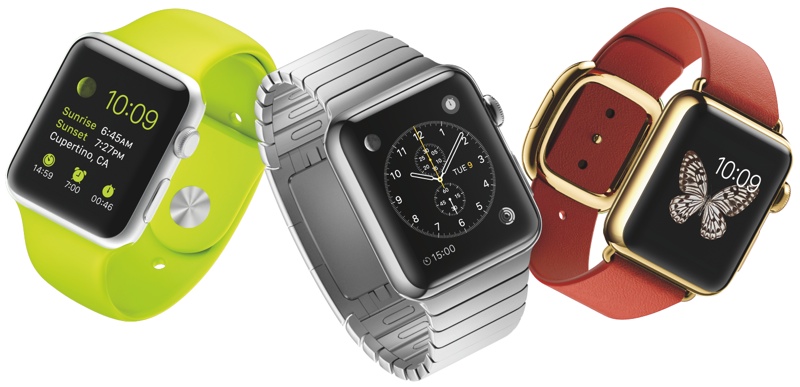
Designed with either an ion-strengthened or flexible sapphire display (depending on model), all of the Apple Watches include an HD Retina screen, sapphire-covered sensors built into the zirconia backing, and an NFC chip to allow the devices to work with Apple's new Apple Pay mobile payment service.
Apple Watch's interface, much like its exterior, has been created with end-user customization in mind. Apple has designed several unique watch faces that users can choose from, featuring traditional watch designs, whimsical characters, animated images, and more, all of which are "extensively customizable." According to Apple, one Apple Watch can have millions of different appearances. Apps on the device are organized into a unique cluster design for quick and easy access.
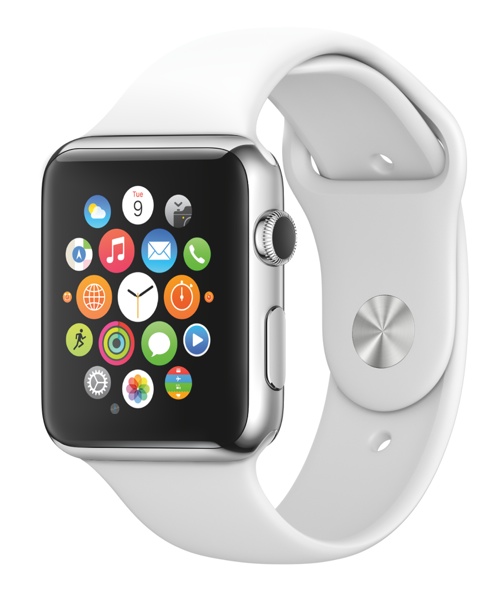
As with all of its products, Apple has carefully considered the way people will interact with and use the Apple Watch, developing both a unique operating system and unique input methods for the device. While it does allow for touch input, Apple Watch also takes advantage of a "Digital Crown" located on the right side of the body, which lets users zoom, scroll, and select elements on the Watch without covering the screen. The Digital Crown also serves as a home button.
A second physical button below the Digital Crown allows users to bring up a list of contacts and then communicate with friends by sending quick drawings, messages, animated emoji, and a heart beat, drawn directly from the watch's included sensors.
Apple Watch takes advantage of new pressure-sensing technology and is able to determine the difference between a tap and a press, enabling a range of contextually specific controls and allowing the device to relay notifications in a subtle way.
There are several different sensors built into the Apple Watch, which allow it to measure metrics like steps taken, calories burned, and pulse rate. Movement information is relayed to two separate fitness-related apps, giving users an overall picture of their daily activity.
Apple's Watch is designed to be a companion device to the iPhone, and as such, it requires an iPhone to function. According to Apple, the Watch is not a standalone device because it relies on the iPhone for many features like relaying notifications and messages. It's also been designed to work with Apple's new Continuity features, letting users shift tasks from one device to another with ease.
There are several Watch features that remain unknown as of yet, including full dimensions of the device, its battery life, and the complete pricing range, but Apple is expected to reveal this information as we get closer to the device's early 2015 launch date.
What We Don't Know
There are several aspects of the Apple Watch that Apple declined to share during it's September keynote event. For example, one of the major questions about the watch concerns its battery, and how long we can expect it to last on a single charge.
Apple did not divulge battery life, and it is likely that since the software remains unfinished, the company has not been able to fully optimize the operating system to get the maximum amount of battery life out of the device.
Current rumors have suggested that the Apple Watch's battery is at "about a day," but it could improve before the device is launched in 2015.
Little information has been made available on pricing, with Apple stating only that Apple Watch prices will start at $349. That figure could change before the device debuts in early 2015, however.
While specific pricing has not been announced, several sites have been speculating on how the devices might be priced. TechCrunch consulted with jewelers and believes the high-end gold Apple Watch could retail for around $1,200. Apple pundit John Gruber, however, has said that he believes the gold Apple Watch could sell for significantly more, possibly at $4,999 or higher. He also believes the stainless steel and sapphire edition could be priced at approximately $999.
Design
According to Apple designer Jony Ive, the Apple Watch is "one of the most difficult projects" he has worked on, and a ton of time went into the design and creation of the device. Apple consulted with several watch historians and Ive himself delved into horological history, studying clocks and watches throughout time while designing the product.
Apple Watch features a rounded, rectangular body in two separate sizes (38 and 42mm) that is able to snap easily into an array of interchangeable bands. There are only two "buttons" on the device, including the Digital Crown that offers several control options and the Friends button that brings up a list of contacts.
Aiming to create watches that would please a wide range of tastes, Apple designed the Apple Watch with four different custom alloys of stainless steel and aluminum in two finishes, along with two formulations of 18-karat yellow and rose gold that are designed to stand up to daily wear.
In total, there are six different body options: Stainless Steel, Space Black Stainless Steel, Silver Aluminum, Space Gray Aluminum, 18-karat gold, and 18-karat rose gold.
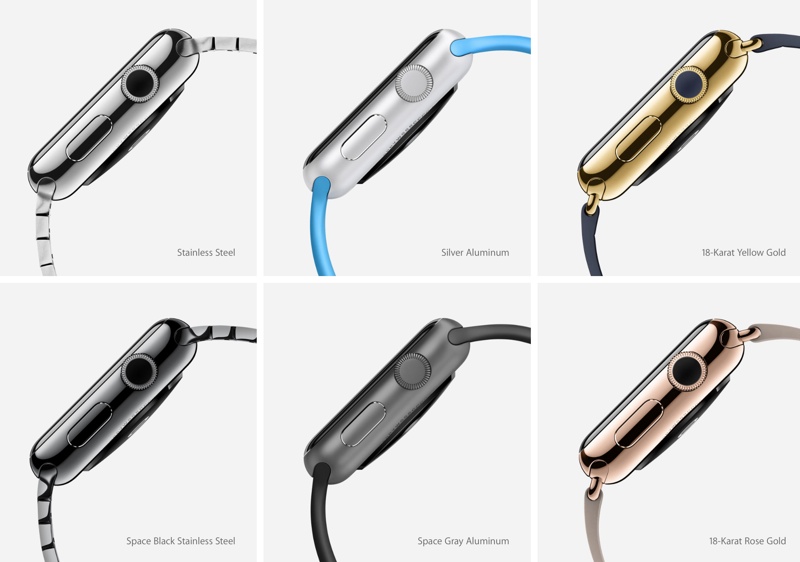
Along with six separate body options, Apple has also designed six types of custom bands for the Apple Watch: Link Bracelet, which is stainless steel and resembles a traditional watch band; Sport Band, made of a flexible and lightweight fluoroelastomer; Leather Loop, a wraparound band constructed from handcrafted leather; Modern Buckle, made from Granada leather and sporting a magnetic buckle;Classic Buckle, made from Dutch leather with a traditional buckle closure; and the Milanese Loop, a flexible metal mesh band designed to wraparound the wrist.
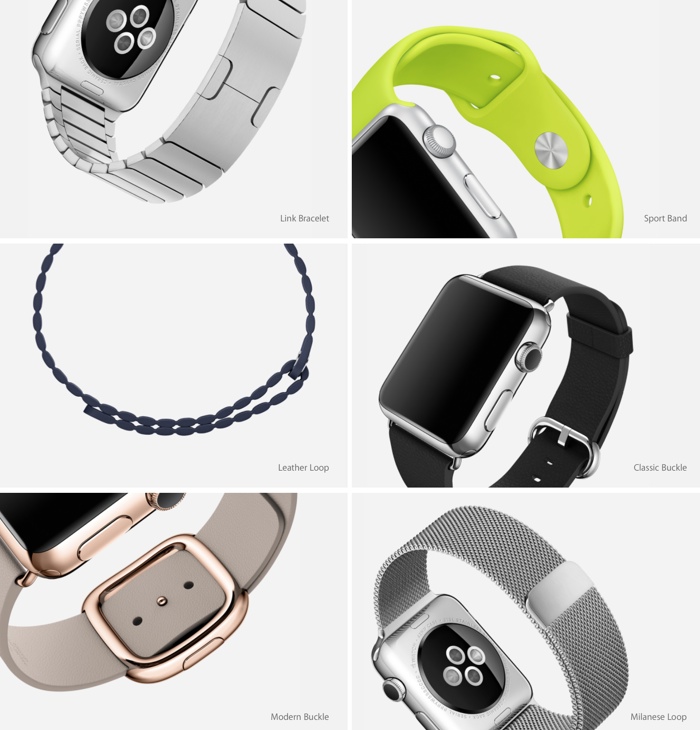
Apple has organized its various watch casings and bands into three separate collections: Apple Watch, Apple Watch Sport, and Apple Watch Edition, each of which group casings and bands that Apple says "work particularly well together."
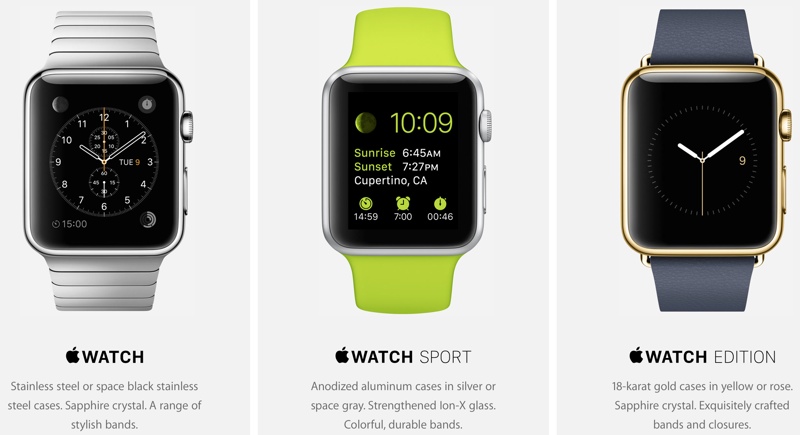
It is unknown at this time if Apple will only be selling the Apple Watch in its pre-arranged configurations or if users will be able to combine any watch casing with any band. It is also unknown if Apple has plans to sell the bands separately, but given their interchangeability, it seems likely that bands will be available on a standalone basis.
APPLE WATCH COLLECTION
The Apple Watch collection includes Apple's stainless steel casings in both a highly polished silver color and space black. These watches feature a durable, scratch-resistant sapphire crystal display and are combined with several of the six available bands in eighteen separate configurations.
The Link Bracelet is available in stainless steel and space black stainless steel, while the Modern Buckle comes in soft pink, brown, and midnight blue. The Leather Loop is available in stone, light brown, and bright blue, and the Classic Buckle comes in black. The Apple Watch casing can also be matched with the Sport bands in black or white.

According to Apple, its stainless steel is made from a cold-forging process designed to make the 316L steel 40 percent harder and more resistant to nicks and corrosion. The black version is coated in a diamond-like carbon layer to achieve its color.
APPLE WATCH SPORT COLLECTION
The Apple Sport collection will likely be the watch collection with the lowest price tag. Aimed at fitness enthusiasts, the Sport watches do not have a sapphire display, instead featuring a lightweight strengthened alumina-silicate Ion-X glass that's "especially resistant to scratches and impact."
Apple's Sport collection also features a lightweight anodized aluminum casing in either silver or space gray. According to Apple, the aluminum used in the Apple Sport Watch is a new alloy (7000 Series aluminum) that's 60 percent stronger than standard alloys. With the Ion-X glass and the aluminum casing, the Sport collection watches are 30 percent lighter than stainless steel models.

Sport watches come with a high-performance fluoroelastomer that's durable and strong, but soft. Apple says it is more flexible than rubber traditionally used in watch bands, for a smooth drape across the wrist, with a pin-and-tuck closure for a close fit. The Sport collection also features the most vibrant colors, with bands in white, blue, green, pink, and black.
APPLE WATCH EDITION COLLECTION
The Edition collection is Apple's high-end luxury lineup, featuring casings crafted from 18-karat yellow or rose gold. Apple metallurgists have designed the gold in the Edition watches to be up to twice as hard as standard gold, which will help keep it free from nicks and scratches.

Like the Apple Watch collection, the Edition collection features a polished sapphire crystal display that's highly durable and scratch-resistant. The Edition collection's gold casings are paired with the Modern Buckle, the Sport Band, and the Classic Buckle, creating six different options.
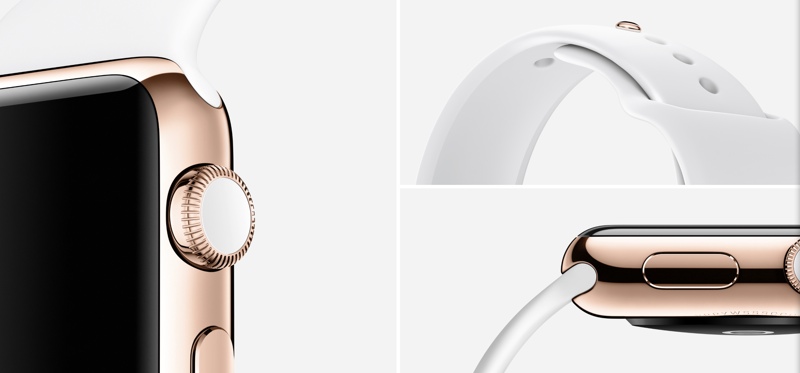
According to an Apple representative who was showing off the device following the keynote event where it was introduced, the Apple Watch Edition will come in a jewelry box that's able to double as a charger. The back of the box is equipped with a Lightning connector, and the magnetic charging pad rests inside. Users can charge the watch simply by returning it to its case at night.
Features
The Apple Watch was created to be a companion device to the iPhone, and as such, it displays notifications when a user receives a phone call, a message, or an app alert. It offers full apps, time keeping abilities, social features, and a unique interface that takes advantage of a vibration-based feedback system and the iPod-style "Digital Crown" scroll wheel.

Though designed as a companion to the iPhone, the Apple Watch will reportedly have a limited number of offline capabilities including the ability to make Apple Pay payments, play music over Bluetooth, track activity, and display some apps.
Apple Watch has a built-in speaker and a microphone and is able to place and receive phone calls. While it is water resistant and able to withstand sweat, rain, and hand washing, it should not be worn while swimming, bathing, or showering.
Apple Watch was also designed to function as a health and fitness device, offering movement tracking capabilities combined with intuitive apps that encourage users to be more active.
Apple custom designed a special S1 processor chip for the Apple Watch, which integrates several different subsystems into a single module. It houses a gyroscope and an accelerometer to measure activity, and a sensor that detects heart rate. The heart rate sensor consists of four sapphire lenses built into the zirconia backing of the watch that detect pulse rate (via infrared, visible-light LEDs, and photodiodes), and the device also integrates the GPS and Wi-Fi capabilities of the iPhone into several of its tracking abilities, using the phone's GPS system to determine distance traveled.
TIME
According to Apple, the Apple Watch was designed to be an "incredibly accurate timepiece" that has a margin of error within 50 milliseconds. It checks against the definitive global time standard on a regular basis, adjusting the time accordingly during daylight savings time or when a user travels from one time zone to another.
Apple's focus on time has also led it to develop a variety of watch faces, offering a range of designs from a standard analog clock to Mickey Mouse to a galaxy theme that includes moon phases and a look at the solar system. Each custom watch face includes several additional customization options, letting users change colors and the information that's displayed.

Apple Watch's accelerometer senses when a user raises his or her wrist, at which point the watch face is displayed. When not activated, the screen remains blank to conserve battery life.
FORCE TOUCH
Pressure-sensing technology called "Force Touch" has been built into the Apple Watch, allowing it to determine the difference between a tap and a press. This functionality allows for a new range of contextually specific controls, almost similar to the different abilities enabled by left clicking and right clicking on a mouse button.
TAPTIC ENGINE
Along with pressure-sensing technology, the Apple Watch has a unique haptic feedback vibration engine that's designed to deliver alerts in a subtle, gentle way, letting users feel and hear the design of the user interface. Tactile sensations will be different for each kind of notification and combined with audio cues for a feedback system that's quite unlike anything available on the Mac or iPhone.
According to Apple, the Taptic Engine will let users feel and respond to notifications "easily and intuitively," and it can also be used for communication with other Apple Watch users.
NFC AND APPLE PAY
Apple Watch includes support for NFC, which allows it to integrate with Apple's new mobile payment initiative, Apple Pay. According to Apple, the watch will be able to be used to make payments at retailers that accept Apple Pay.
The built-in heart rate monitor will be used to ensure secure payments through skin contact. When the Apple Watch is first put on the wrist, a user enters a PIN code to authorize Apple Pay. After that point, the watch monitors skin contact and if removed from a wrist (in the event of a theft, for example) the device is no longer able to make payments until the PIN is reentered.
CHARGING
The Apple Watch uses inductive charging, taking advantage of a Magsafe-style magnetic charger that snaps easily onto the back of the device.
Watch OS
Watch OS is an entirely new operating system that's designed to allow the Apple Watch to connect to the iPhone. Watch OS, which has taken design cues from iOS 7 and iOS 8, performs several different functions, including displaying the watch face, the home screen, full on apps, and notifications or quick information, which Apple calls "Glances."
The default view on Watch OS when the wrist is raised is the watch face, which offers the time and any other user-selected information. Swiping allows users to access Glances, which are essentially small bits of information that can be digested in a glance. For example, Glances might include the time of a user's next scheduled appointment or the current weather.
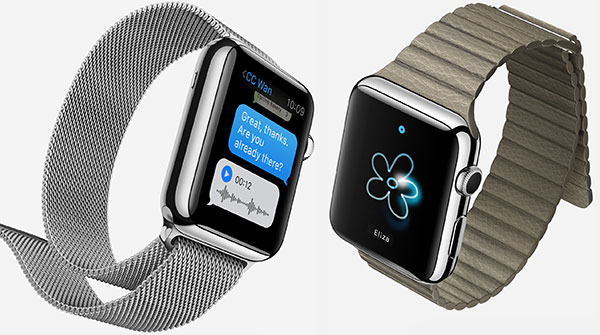
The home screen is accessed by pressing on the Digital Crown, and it displays all available apps in a cluster format (or "app neighborhood") that can be navigated with swipes or with the Digital Crown control. From the home screen, individual apps like the built-in Fitness or Workout programs can be accessed via a tap.
Apps on the Apple Watch are similar to apps available for the iPhone, but more limited. During Apple's keynote presentation, Messages was shown with options for quick replies and emojis rather than complete responses, while a Camera app functioned as the iPhone's viewfinder.
DIGITAL TOUCH
Social interaction is a cornerstone of Watch OS, and the various sensors and technological capabilities built into the Apple Watch allow for new ways of communication between users, mainly through a set of features Apple's named "Digital Touch."
With Digital Touch, users can send taps to each other or take advantage of the touch screen to draw and send simple sketches. Apple Watch has specially designed animated emoji, plus a list of pre-determined response messages (which improve over time based on user input) that can be used as text message replies. It's also possible to use the built-in heart rate monitor to send an actual heartbeat to another user, which is relayed through vibrations and a heart on the watch display, and there's a "Walkie-Talkie" feature for sending quick sound bites to friends.
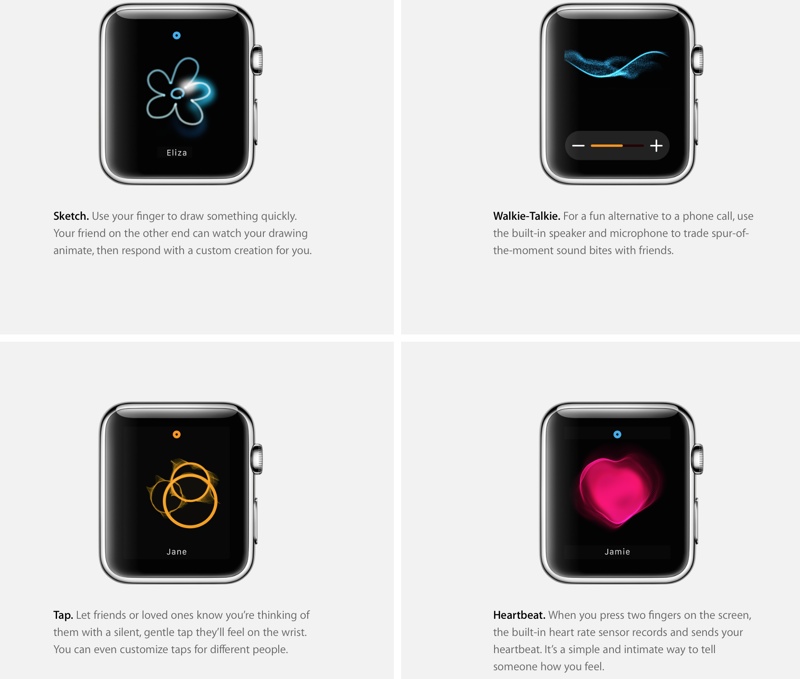
FITNESS
There are two separate fitness apps installed on the Watch, each designed to track different fitness elements. The Activity app gives users an overview of their daily fitness levels, with three "rings" representing calories burned, exercise completed, and how often a break is taken from sitting. Fitness has a companion iPhone app to let users track trends over time.
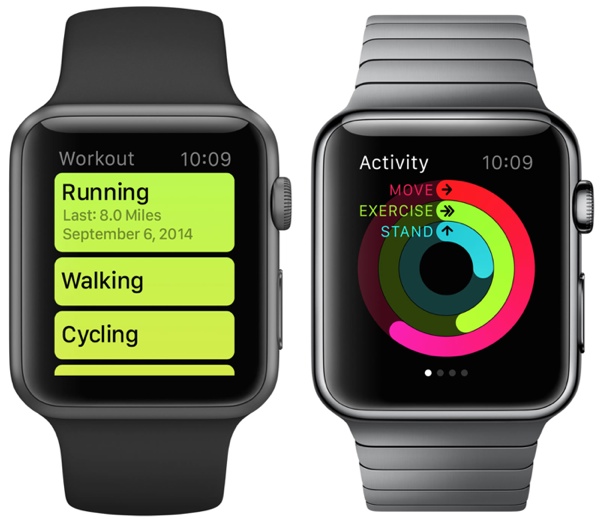
A second Workout app displays real-time stats like time spent exercising, distance traveled, calories burned, and pace when working out. It encourages users to set, meet, and beat fitness goals, and over time, it is able to suggest new, attainable fitness goals and act as a digital personal trainer.
SIRI
As might be expected from a device with limited space for user input, the Apple Watch includes Siri integration. Users will be able to ask Siri to perform many of the tasks the personal assistant is able to perform on the iPhone, such as sending messages, getting directions, or looking up information.
Siri can be activated by holding down the Digital Crown or raising a wrist and using the "Hey Siri" command.
OTHER APPS
For the most part, apps that have been shown off so far have been more limited versions of some of the apps available on iOS and OS X. For example, the included Messages app lets users dictate messages or select quick responses from pre-set options.
The Phone app, meanwhile, lets users conduct quick conversations that can be transferred to the iPhone, a car's speakerphone, or a Bluetooth headset, if desired. Incoming phone alerts can be silenced by covering the Apple Watch with a hand.

Mail, another app present on Watch OS, will display incoming email messages. Users can read messages, flag it, mark it read/unread, or move it to trash, but will need to transfer to an iPhone to type a response. Other built-in apps:
- Calendar: Displays what's coming up next in a user's day, sends meeting reminders and allows users to accept calendar invitations.
- Maps: Lets users view current location and get turn-by-turn directions. Maps takes advantage of Taptic Feedback, delivering different vibrations for a left or right turn.
- Passbook: Like on the iPhone, Passbook stores boarding passes, tickets, loyalty cards, and credit cards. It's an integral part to Apple Pay via Apple Watch.
- Music: Users will be able to control the music on their iPhones via Apple Watch and Apple Watch can also play music directly.
- Apple TV, iTunes: Apple Watch can serve as a remote control for both iTunes and the Apple TV, letting users navigate the interface with the watch.
- Camera/Photos: Apple Watch serves as a remote shutter for the iPhone's camera. It can display a live preview of what the iPhone sees, and snap the picture. Apple Watch also displays photos that are favorited on the iPhone in its Photos app.
- Clock: Similar to the iPhone's clock app, Apple Watch will have stopwatch, timer, and alarm functionality built in, along with a world clock.
- Weather: Apple Watch will allow users to see the weather in their immediate location or anywhere in the world. The app displays a detailed daily report and a weekly forecast.
- Settings: A Settings app serves as a hub to enable and disable various Apple Watch features, including Bluetooth, Do Not Disturb, and Mute. This app also lets users ping their iPhones to determine its location should it become lost.
Apple Watch will support third-party apps, allowing developers to create three distinct types of software for the device: "Actionable Notifications" that are essentially interactive third-party app notifications sent from the iPhone, Glances, which display quick bits of info, and full on apps that run on the Apple Watch itself.
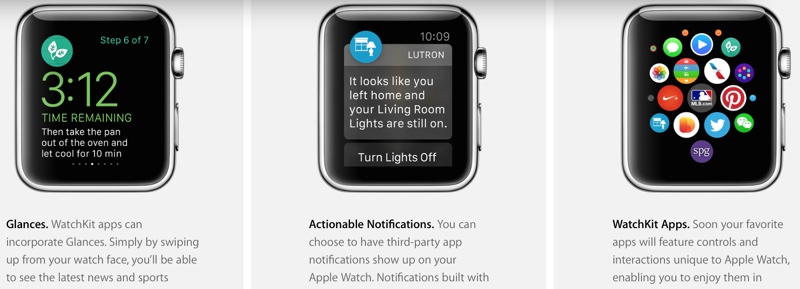
CONTINUITY
Watch OS, like OS X Yosemite and iOS 8, will support Apple's new Continuity features that allow the operating systems to integrate with in innovative ways. With Handoff, for example, users are able to shift tasks from one device to another with ease, and Apple Watch may also take advantage of SMS Relay to accept texts and phone calls.
Hands-On First Impressions
After the September 9 event where Apple debuted its new Apple Watch, attendees were invited to go hands-on with the device, giving an overall picture of the look, feel, and function of the device.
While most models on display were not running the actual WatchOS software, Jared Nelson from our sister site TouchArcade was able to get a hands-on walkthrough of a device working from an employee, as seen in the video below.
Initial impressions of the Apple Watch were highly positive, with The Verge saying the smaller watch model felt "very solid and surprisingly light," and the wrist strap was "supple" and comfortable to wear.

Engadget said that the bands for the watch had an "impeccable" build quality and were "comfy," whileGizmodo said that the device felt "significantly more premium" than competing watches from LG and Samsung. The site also praised the Digital Crown, saying "it feels like you're wearing a watch that just happens to be digital."

Pricing and Availability
Little information has been divulged about the Watch's price, but Apple has revealed that pricing will start at $349 for the entry-level device. Apple has also not provided a specific launch date, but plans to release the device in "early 2015."
According to recent employee comments, Apple will be "lucky" to ship the Apple Watch by Valentine's Day. The company was reportedly aiming for a late 2014 release for the device, but ran into issues with the software that caused a delay.
Apple Watch Timeline
OCTOBER2014
SEPTEMBER2014
No comments:
Post a Comment